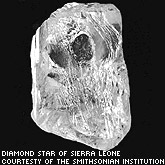You, Graphite and Diamonds
 Living things, including you and me, and diamonds, are made of the same substance: the element carbon (C). Carbon atoms in our bodies are bound to other atoms, such as hydrogen and oxygen, in organic molecules, while those in a diamond are bound to other carbon atoms to form a pure crystalline structure. Another form of pure carbon is graphite. Even though we are carbon relatives with graphite and diamonds, diamonds are by far the strongest.
Living things, including you and me, and diamonds, are made of the same substance: the element carbon (C). Carbon atoms in our bodies are bound to other atoms, such as hydrogen and oxygen, in organic molecules, while those in a diamond are bound to other carbon atoms to form a pure crystalline structure. Another form of pure carbon is graphite. Even though we are carbon relatives with graphite and diamonds, diamonds are by far the strongest.
In a diamond, all four outer electrons of the carbon atom are covalently bonded to other carbon atoms to form an extremely strong three-dimensional crystalline structure. In contrast, only three of the four outer electrons of the carbon atom are bonded to other carbon atoms in graphite; forming sheets of carbon atoms rather than a 3D crystal. Hence graphite is very slippery (carbon sheets slipping on top of each other) and breakable, while diamonds are the hardest material on Earth.
All diamonds were formed between 1 and 3 billion years ago by a combination of extremely high temperatures and pressures, about 100 miles (160 km) deep inside the Earth. At the same temperature, graphite only needs a third or a quarter of that pressure to form. As a result, graphite forms much closer to the Earth's surface and is easily mined. So how do we extract diamonds? Do we dig mines 100 miles deep? Fortunately, we don't have to. Diamonds get carried up to the surface by volcanic eruptions while embedded into volcanic rock known as kimberlite. Volcanic eruptions travel upwards at speeds anywhere between 10 and 100 mph (16 to 160 km/h). If they traveled much slower, diamonds would convert to graphite on the way up. We would have never known about diamonds, and engagements would have had a whole different feel to them … a slippery and black one.
About the Author
Anton Skorucak, MS
 Anton Skorucak is a founder and publisher of ScienceIQ.com. Anton Skorucak has a Master of Science (MS) degree in physics from the University of Southern California, Los Angeles, California and a B.Sc. in physics with a minor in material science from the McMaster University, Canada. He is the president and creator of PhysLink.com, a comprehensive physics and astronomy online education, research and reference web site.
Anton Skorucak is a founder and publisher of ScienceIQ.com. Anton Skorucak has a Master of Science (MS) degree in physics from the University of Southern California, Los Angeles, California and a B.Sc. in physics with a minor in material science from the McMaster University, Canada. He is the president and creator of PhysLink.com, a comprehensive physics and astronomy online education, research and reference web site.


